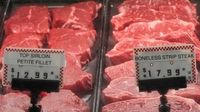President Donald Trump’s recent proposal to dramatically increase imports of Argentine beef into the United States has sent shockwaves through the American agricultural sector, igniting fierce backlash from ranchers, lawmakers, and industry groups who feel betrayed by what they see as a departure from his long-touted “America First” agenda. The move, announced in mid-October 2025, comes at a time when U.S. consumers are already grappling with record-high beef prices, and American cattle producers are struggling with diminished herds, rising costs, and fallout from ongoing trade disputes.
On October 19, President Trump suggested that importing beef from Argentina would help bring down U.S. grocery prices. He told reporters, “They’re fighting for their life. You understand what that means? They have no money, they have no anything. They’re fighting so hard to survive. If I can help them survive in a free world — I happen to like the president of Argentina, I think he’s trying to do the best he can. But don’t make it sound like they’re doing great.” According to The Hill, Trump’s comments were part of a broader effort to support Argentine President Javier Milei, a political ally, as he faces economic and electoral crises at home. The proposal reportedly includes quadrupling the quota for tariff-free Argentine beef and follows a controversial $20 billion U.S. bailout for Argentina, even as a government shutdown in Washington left thousands of federal workers unpaid.
The response from America’s heartland was immediate and visceral. Senator Deb Fischer (R-Neb.) took to X (formerly Twitter) to declare, “Nebraska’s ranchers cannot afford to have the rug pulled out from under them when they’re just getting ahead or simply breaking even. I strongly encourage the Trump administration to focus on trade deals that benefit our ag producers—not imports that will do more harm than good.” She added that she had already communicated her “deep concerns” to the administration, highlighting the bleak state of the agricultural economy in Nebraska, a state where cattle ranching is a vital economic driver.
Other Republican lawmakers echoed these sentiments. Senate Majority Leader John Thune (R-S.D.) told Semafor that the “ideal” scenario would be to avoid importing beef from Argentina altogether, saying, “This isn’t the way to do it. It’s created a lot of uncertainty in that market. So I’m hoping that the White House has gotten the message.” Meanwhile, eight House Republicans signed a letter questioning Trump’s plan and noting that the cattle industry contributes $112 billion to rural economies nationwide.
Ranchers themselves have not minced words. Kyle Hemmert, a cattle rancher in western Kansas, told The New York Times, “It’s really just a kick in the nuts. Come on President Trump, this is ‘America First’ policy? No.” Christian Lovell, a cattle producer and leader in the nonpartisan farm organization Farm Action, called the plan “a betrayal of the American rancher,” pointing out that after the administration’s trade war crashed the soybean market, it now threatens to do the same to cattle.
Social media has amplified these frustrations. Meriwether Farms in Wyoming, in a post that quickly went viral, stated, “Your suggestion to buy beef from Argentina to stabilize beef prices would be an absolute betrayal to the American cattle rancher. On top of all this — there is only chaos coming from the Department of Agriculture. There is no true guidance, mixed messaging, and a copious amount of photo ops.”
The National Cattlemen’s Beef Association (NCBA) has been especially vocal in its opposition. CEO Colin Woodall said in a statement, “This plan only creates chaos at a critical time of the year for American cattle producers, while doing nothing to lower grocery store prices. … Argentina also has a history of foot-and-mouth disease, which, if brought to the United States, could decimate our domestic livestock production.” The NCBA further called Trump’s proposal an “effort to manipulate markets” that risks “damaging the livelihoods of American cattlemen and women, while doing little to impact the price consumers are paying at the grocery store.”
Trump, for his part, has remained defiant in the face of criticism. On Truth Social, he wrote, “The Cattle Ranchers, who I love, don’t understand that the only reason they are doing so well, for the first time in decades, is because I put Tariffs on cattle coming into the United States, including a 50% Tariff on Brazil. If it weren’t for me, they would be doing just as they’ve done for the past 20 years — Terrible! It would be nice if they would understand that, but they also have to get their prices down, because the consumer is a very big factor in my thinking, also!”
But the numbers tell a different story. According to the U.S. Bureau of Labor Statistics, the price of ground beef reached $6.63 per pound in August 2025, up 15 percent from the previous year. This surge in beef prices has been a significant driver in the 3.1 percent increase in overall food prices. Industry experts and ranchers argue that flooding the market with Argentine beef is unlikely to bring meaningful relief to consumers, while potentially devastating domestic producers already hammered by drought, high feed costs, and a national cattle herd at a 75-year low.
Meanwhile, the structure of the U.S. beef industry has left independent ranchers squeezed. As Bloomberg reported, just four meat processing companies control over 80 percent of the nation’s beef, giving them disproportionate power over pricing and supply. Ranchers and advocacy groups are calling for a return to mandatory Country of Origin labeling, more regional processing plants, support for restocking herds, and easier interstate sales — rather than simply opening the floodgates to foreign imports.
Trump’s trade policies have already had far-reaching effects on American agriculture. Soybean farmers, once major supporters, were dealt a blow when China — which buys $12.6 billion worth of U.S. soybeans according to The New York Times — refused to purchase more in response to Trump’s trade war. The American Soybean Association’s president, Caleb Ragland, expressed frustration over falling prices and Argentina’s ability to sell soybeans to China, saying, “U.S. soybean prices are falling, harvest is underway, and farmers read headlines not about securing a trade agreement with China, but that the U.S. government is extending $20 billion in economic support to Argentina while that country drops its soybean export taxes to sell 20 shiploads of Argentine soybeans to China in just two days.”
White House spokesperson Kush Desai has insisted that the administration remains “committed to addressing the needs and concerns of American cattle producers and safeguarding their interests at home and abroad,” touting “billions in new export opportunities for American agricultural products in our historic trade deals.” The administration has also announced plans to bolster the U.S. beef supply by increasing access to grazing land, reducing inspection costs, and encouraging domestic demand for beef. However, many in the industry remain unconvinced, especially as they watch the administration prioritize foreign alliances over the livelihoods of American farmers.
As the dust settles, the rift between the Trump administration and its agricultural base appears deeper than ever. Whether the White House will heed the warnings from Congress, industry groups, and the ranchers themselves remains to be seen. For now, American cattle producers are left to wonder if the “America First” promise has been left behind in the pastures.




